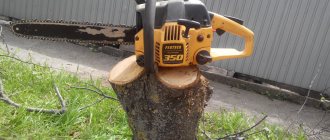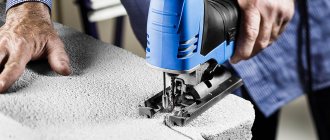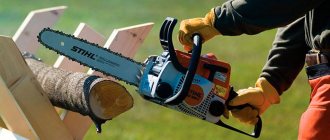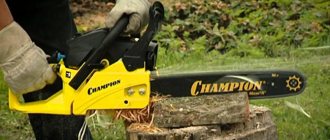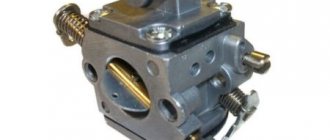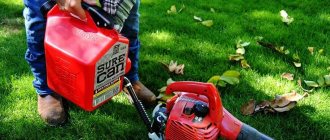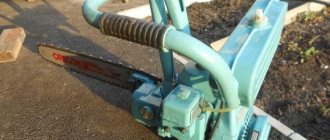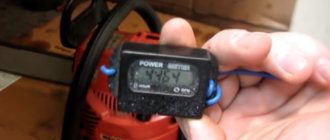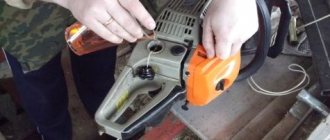Why does a chainsaw smoke as soon as it starts, and then stops, is this normal or not?
A chainsaw is a simple device that, with proper care, can last a long time. At the same time, the saw is a tool subject to various loads and, therefore, breakdowns still occur. You will learn about what caused a certain malfunction and how to fix it from this article.
Necessary skills and tools for repair
Most of the malfunctions of gasoline chain saws can be fixed with your own hands. True, this requires an understanding of the structure of the chainsaw and how the components function among themselves. As for the tools, the most often needed are:
- screwdrivers (slotted and power);
- combination wrench included in the kit or regular wrenches with heads of various sizes.
Repair it yourself or send it to a service center
It is worth understanding that not every problem can be solved on your own. Not every chainsaw owner has a compression gauge at home or a special device that allows you to create a vacuum and the required pressure, for example, to check the crankcase for leaks. In this case, you simply cannot avoid contacting specialized specialists.
Troubleshooting algorithm
If you are absolutely sure that you can assemble the chainsaw after disassembling, then a screwdriver is in your hands. To determine the true cause of the problem, it is necessary to analyze the condition and behavior of the saw.
Engine
In most cases, the following problems occur in engine operation:
- the engine stopped starting;
- the engine starts, but after a while it stalls;
- the engine is not able to develop the required power;
- The engine is extremely unstable.
How to check crankshaft seals
The presence of oil seal leaks can only be checked by getting to the crankshaft itself and carefully examining it for leaks. You can see how to do this correctly in the video:
How to check compression on a chainsaw
At a compression level below 8 atmospheres, the engine will not have enough power, which means the chainsaw will not be able to fully function.
To measure compression you need:
- Remove the protective cover and unscrew the spark plug.
- Insert the tip of the compression gauge into the hole where the spark plug should be located.
- Using the starting cord, rotate the piston and remember the maximum readings of the measuring device.
How to properly install a piston on a chainsaw
The work of replacing the piston for most models of modern chainsaws is carried out according to the following algorithm:
- The top and side covers are removed.
- The candle is unscrewed.
- The stoppers are removed from the shock absorbers and the handle is disconnected from the body.
- The drive sprocket and starter are removed.
- A piston stopper is installed in the spark plug hole and the nut securing the flywheel and clutch is unscrewed.
- The flywheel, clutch, and worm drive of the oil pump, located immediately behind the clutch mechanism, are removed.
- The screws securing the carburetor and air filter are unscrewed, after which these components are removed along with the engine control lever.
- The ignition coil is removed, as well as the muffler.
- The saw is turned upside down and, by unscrewing the screws securing it to the body, the engine is disconnected.
- The pan is unscrewed and the piston is removed.
- Since the piston is removed only together with the crankshaft, to disconnect it it is necessary to remove the retaining rings.
- The old piston is replaced with a new one, but as carefully as possible. This is caused by the high fragility of compression rings.
- The crankcase is put in place, and sealant is used instead of a gasket.
All subsequent actions are carried out according to the reverse algorithm of disassembly.
How to remove the chainsaw clutch.
1. In order to remove the clutch on a chainsaw, you must first remove the cutting set, then the air filter cover and the clutch cover.
2. Then you need to lock the crankshaft so that it does not rotate when the clutch is unscrewed. To lock the crankshaft, for example, with a large crank, you need to remove the cover of the manual starter and screw two bolts into the rotor of the ignition system. Or unscrew the spark plug, lower the piston to BDC and stop it there by pushing a rope into the spark plug hole.
3. Next, unscrew the clutch itself - using a key from the chainsaw kit, or a wrench for grinder wheels, or a homemade wrench (for example, from an old tire with two bolts), unscrew the clutch clockwise (there is a left-hand thread), it takes considerable force to break it.
4. Then remove the drum with the drive sprocket from the chainsaw. Replacing the clutch drum of a chainsaw is done according to the rule: replace two tires - replace one drum.
5. Then install the new clutch and tighten it by hand until it stops (twist counterclockwise). In this case, you need to lock the crankshaft again so that when turning the clutch you do not break the starter located at the other end of the chainsaw crankshaft.
6. Then everything is assembled in the reverse order of disassembly.
7. To tighten the clutch on the chainsaw completely, you need to move the chain brake handle forward, start the chainsaw and then release the brake.
Problems starting the engine
It is very important to correctly determine the cause of the malfunction, because otherwise we simply cannot eliminate it. If when trying to start the chainsaw there are no extraneous sounds (knocking, grinding, etc.
) then very often it turns out that in fact there is no breakdown. For example, if you start the chainsaw incorrectly and pull the choke for a long time, the engine simply floods and it is very difficult to start it.
In order to properly start a cold chainsaw engine, set the lever or switch to the “damper closed” position. Then you need to pump the mixture into the carburetor, if there is a fuel priming pump. Pull out the starting handle until the engine resistance becomes noticeable, and vigorously pull in amplitude, moving your hand to the side. After two or three such movements, the engine should first start and then stall. If this does not happen, then you need to move the lever to the half-throttle position or simply to the working position and then continue to start the chainsaw in this mode. On many chainsaws, the “half throttle” is automatically locked when the air damper is pulled out.
Some models have a key ignition switch, it is important to make sure it is turned on
If the engine does not start, then the first thing to do is unscrew and inspect the spark plug. There are cases when at a plant in the cold season, the combustion chamber is filled with fuel. Then you also need to unscrew the spark plug, dry the combustion chamber by idling, clean the spark plug, screw it in and repeat the start. It is advisable to immediately check for the presence of a spark - put a cap with a high-voltage wire on the unscrewed spark plug, place it on the cylinder and pull the starter. Visually we observe a frequent blue spark - good. Screw the spark plug into place and start it. If there is no spark, change the spark plug and try again. No again - we check the connection of the high-voltage wire to the spark plug, the coil and the ignition system.
In general, the type of malfunction can be judged by the condition of the spark plug.
- Dry. Most likely, the fuel mixture is not getting into the cylinder. The problem is not in the ignition system, so screw the spark plug back in and check the fuel supply system.
- Wet, heavily splashed with fuel. The reason for the excess fuel mixture lies either in a violation of the starting rules, as described above, or in incorrect carburetor adjustment.
- Covered with black soot. This may indicate the use of low-quality oil, an incorrectly adjusted carburetor, or an incorrectly calculated ratio of gasoline to oil. The spark plug should be washed, removed from carbon deposits with a sharp object (an awl or a needle), the electrodes should be wiped with sandpaper and placed in place.
When checking the spark plug, you need to pay attention to the gap between the electrodes: 0.5 to 0.65 mm is considered normal. Damaged or worn gasket must be replaced
Chainsaw ignition system malfunction
Problems in the ignition system most often cause engine failure in gasoline powered tools. Therefore, it is necessary to begin troubleshooting.
Examine the candle. To do this, carefully remove the high-voltage wire from the head, and then unscrew the spark plug from the socket using a special key.
If the spark plug is wet, there is excess fuel. Most often the feed
excess fuel is due to incorrect carburetor settings or problems in the ignition system.
The candle should be thoroughly wiped with a dry paper towel and dried. Additionally, you will need to drain the cylinder, shut off the fuel supply, and run the starter several times to remove excess fuel mixture.
After these steps, you need to replace the spark plug, open the fuel supply and try again.
If there is a noticeable amount of black carbon visible on the plug, this usually indicates a problem with the fuel supply - an imbalance in the gasoline/oil ratio, poor quality oil, or the need for carburetor adjustment.
Read:
In this case, the spark plug should be cleaned with a needle or a sharp awl from the accumulated sediment, cleaned with an electrode and sandpaper until a metallic sheen appears and screwed into place. In this case, you need to rely on the tightness of the spark plug gasket.
If the chainsaw
does not start in any case, you need to check for spark in the spark plug. Once the high tension wire cap is on, we will put the spark plug skirt on the cylinder and pull the starter as shown in the photo below: If the blue spark jumps from a distance of 2-3mm, then everything is ok. If the spark appears only at a distance of 0.5-1 mm, most likely there are problems with the ignition system. If there is no spark, you need to check the high voltage cable using a probe. There was probably a break in the wire. If all the above steps do not lead to success, try replacing the spark plug with a known good and try starting the chainsaw again.
In addition, the lack of a spark may be due to a violation of the gap between the ignition module and the magnetic flux of the flywheel. The gap should be 0.2 mm. The required gap can be set using a gasket with a diameter of 0.2 mm, which is placed between the flywheel and the ignition module.
Fuel system
Malfunctions of the fuel system are also quite often the main reason that prevents a chainsaw from working as efficiently as possible. First of all, you need to check the quality of the fuel mixture.
Some owners prefer to use alcohol-containing solutions rather than the recommended brand of gasoline, or add more oil than required.
Gasoline leaks from a chainsaw
If gasoline drops periodically appear on the body of the chainsaw, then it is necessary to check the tightness of the fuel tank. Over time, it may dry out. Or the gasket has become “stiff” and it can no longer perform its direct function.
If full-fledged gasoline streams appear, then there is a high probability that you will have to change the burst hose connecting the carburetor and the fuel tank.
Gasoline does not enter the chainsaw cylinder
There are several reasons why the fuel mixture stopped flowing into the cylinder:
- The air filter is clogged.
- The carburetor settings have been lost.
- The carburetor membrane is no longer intact.
- The channels through which gasoline is transported are clogged.
Chainsaw won't idle
In this case, you should start looking for a problem with the filter elements. For the most part, it is precisely because of the reduced capacity of the air and gasoline filters that the idle speed begins to “float”.
If everything is in order with the filters, then you need to check the components of the gas supply system, and also make sure that there are no spontaneous changes in the carburetor settings.
Why does colored (for example, white) smoke come from the exhaust pipe?
Color in this case speaks volumes. For example, blue (from blue to dark shade) means that oil has entered the engine cylinder. This process is often accompanied by increased fuel consumption. Often blue color indicates failure of elements of the cylindrical and piston groups
When diagnosing, it is important to inspect the areas in direct contact with the cylinder. In addition, you need to check the side surfaces and recesses of the piston rings
The problem here arises due to sealing of the gaps, which is caused by the excessive volume of oil entering the system. Minor contamination does not cause a visible compression failure, but it is necessary to check this possibility when thick blue exhaust appears. A white-blue tint in combination with excessive fuel consumption can also be a sign of a valve seal failure and an ignition malfunction. New cars “smoke the air” in the same way, but the smoke gradually dissipates (in this case there is no reason to worry).
The black version indicates potential breakdowns:
The “charcoal” tint appears due to excessive concentration of fuel in the fuel-air mixture.
As a result, the fuel does not burn through completely, which makes the exhaust toxic.
The most common cause is a malfunction of the fuel supply or ignition system. A gray-black color indicates a carburetor malfunction. The reason is that the float chamber overfills due to clogged jets or faulty needle parts. In this case, you need to clean the camera. If this does not help, replace the parts using a repair kit.
What kind of fuel should you fill your chainsaw with?
It's no secret that expensive imported chainsaws are very sensitive to low-quality fuel. At the same time, tool owners are the last ones to blame local diesel fuel, considering regular jamming of the saw as a sign of failure of mechanical parts.
Many manufacturers even block users' access to the carburetor so that they do not change the composition of the air-fuel mixture themselves. For this purpose, the jets (holes for supplying the mixture) are made unadjustable.
Fill your chainsaw with fuel recommended by the manufacturer.
Therefore, always prepare a fuel mixture of high-quality gasoline and oil of the brands recommended by the manufacturer. There is no need to prepare the fuel mixture for future use - its quantity should be enough for a couple of weeks of work. Gasoline “stayed” in a canister for a month loses its octane characteristics and the saw is guaranteed to jam.
Chainsaw chain problems
In addition to problems with the engine, the chainsaw may experience operational problems due to a malfunction of the cutting (sawing) unit, consisting of an oil pump, bar and saw chain.
There is no oil getting to the tire
Usually, if oil does not flow to the chainsaw chain, you need to check the channels through which oil is supplied to the tire and clean them of dirt. If the previous steps did not reveal the cause of the problem, then you will have to check the oil pump. To do this you need:
- remove part of the chainsaw casing;
- remove the coupling;
- unscrew the 3 screws and remove the cover hiding the pump;
- get to the worm gear gear that rotates the pump shaft.
If the thread on it is worn out, the shaft does not rotate, the pump does not work, and the chain is not lubricated. A worn gear needs to be replaced. You can also remove the oil pump itself and manually try to pump oil through it. If it does not pump, the pump should be replaced.
Chainsaw oil filter
Also, a lack of lubricant may be due to its leakage. You should check how tightly the pipes coming from the oil pump are connected. If the tightness is broken, the tubes are replaced with new ones.
The chain breaks
If the chain breaks while the chainsaw is running, this could happen when it hits a hard object, such as a nail. If the chain constantly breaks, then the reasons may be the following.
- Low quality of the metal from which the saw chain is made. It is necessary to buy gas cutter saws from reputable brands.
- Chain overheating due to poor lubrication. As a result, the saw overheats, the properties of the metal change, and it breaks under load. It is necessary to check the entire chainsaw lubrication system (discussed above).
You can also learn about the reasons for frequent circuit breaks from this video.
The chain doesn't turn
This nuisance often plagues inexperienced chainsaw owners. They forget to remove the brake after starting the engine. As a result, the chain does not spin, the brake system overheats, and the clutch mechanism fails. The problem is solved by removing the saw from the brake. If the clutch is not burnt out, you will notice the chain turning. Otherwise, the clutch mechanism will need to be replaced.
The chain gets dull quickly
Basically, the reason that the chain becomes dull quickly is the poor quality of the saw. Trying to save money on buying branded chains, chainsaw owners buy saws from unknown manufacturers, or, due to inexperience, purchase counterfeits of well-known brands. It is best to buy a cutting element for a gas cutter in company stores. Stihl saw chains are very popular among owners of this equipment.
The chain doesn't stop
If, when working with a chainsaw, you notice that the saw chain does not stop at the right moment, then this breakdown may have 2 options.
- The brake band is dirty. When operating the saw, dirt, sawdust, dust, etc. may get under the band. As a result, the brake mechanism becomes blocked and the chain does not stop when the gas is released. The problem is eliminated by cleaning this unit.
- The brake band is worn out. This element of the brake system needs to be replaced.
The chain is jammed
This happens when the drive or driven sprocket wears out. The chain usually starts to jam under load. But without load the saw can rotate. The photo below shows a worn chainsaw drive sprocket.
The next photo shows that the reason why the chain jams must be looked for at the location of the driven sprocket.
But what to do if the chainsaw is completely jammed, and all attempts to pull the starter are unsuccessful? This malfunction sometimes occurs on Chinese-made chainsaws. It is caused by the bolts that screw the engine to the plastic casing of the unit becoming loose due to vibration. These bolts are located directly under the flywheel (magneto). In the photo below, arrows show the location of the problem bolts.
As they unscrew, they begin to rub against the flywheel and can completely jam the chainsaw. The following photo shows the flywheel with some scuff marks from the bolts.
To fix the problem, you will need to remove the flywheel from the engine shaft and tighten the bolts.
The chainsaw cuts crookedly
This problem can occur if the chain is dull or improperly sharpened. This applies to a greater extent to new chainsaws. But if the tire is worn out, then even after replacing the chain you will notice that the saw is pulled to the side. Tire wear can be easily determined by placing it on a level table and applying a square to it, as shown in the following photo.
In this case, you can see that there is a gap of about 2 mm between the tire and the corner. It is because of this one-sided tire wear that the chainsaw cuts crookedly. The problem can only be solved by replacing the tire with a new one.
How to eliminate the possible risks of purchasing counterfeit tires?
The information field contains signs by which it is easy to distinguish an original branded chainsaw from the most reliable fake. As for tires, their advantages and disadvantages manifest themselves directly in operation.
In the domestic market of household appliances, about 15% of the total sales of chainsaw components are third-rate counterfeits of unknown origin, producing at best half of the standard resource.
Operating a chainsaw complete with a fake bar and chain is economically unprofitable and unsafe. A significant number of traumatic situations are created when using counterfeit tires and chains.
You can buy a high-quality and durable branded tire of the desired model, without significant risks, at a branded outlet or representative office of a licensed dealer company. If this is not possible, you should use the services of a reputable online store that has earned the trust of customers.
Read also: Channel dimensions table weight per meter
Typical malfunctions of chainsaws
Having determined the causes of the chainsaw breakdown, you can begin to eliminate them. To eliminate this or that breakdown, you need to know what methods exist for this. First, let's figure out what malfunctions of chainsaws can arise during their operation:
https://youtube.com/watch?v=ENK8zzdueQw
- Engine problems. The engine may not start or may stall immediately after starting. In addition, there may also be problems such as the inability to develop full engine power, which can often depend on the quality of the air-fuel mixture. If the engine runs unstably, then it is time to diagnose it.
- Malfunctions in the ignition system. If the engine does not start, you should first inspect the spark plug. The presence of carbon deposits on the spark plug indicates that the ratio of gasoline and oil is incorrect or that one of these substances is of poor quality. If the spark plug is wet, this indicates an excess of fuel. The carburetor must be adjusted correctly. Be sure to check the presence of a spark on the spark plug, which will ensure that it is working properly.
- Failures in the fuel supply system. The reasons for the inoperability of this system are: contamination of the fuel filter, clogging of the hole in the tank cap, as well as insufficient amount of fuel mixture entering the cylinder.
- Carburetor failure. It is necessary to check this mechanism and clean it. Determining the cause of a malfunction in the carburetor is quite problematic if there is no experience, so it is recommended to contact specialists.
- Malfunction of the exhaust gas removal system. Over time, the walls of the exhaust pipe become clogged with carbon deposits, which helps reduce the diameter of the exhaust pipe.
- Piston or cylinder failure. They are one of the most serious breakdowns, as a result of which a major overhaul of the engine will be required. Scratches and scuffs appear on the piston or cylinder, and the piston rings or crankshaft bearings wear out.
- Chain lubrication system malfunction. If there is no oil supply to the chain, this can lead to a number of negative consequences. Therefore, it is recommended to check its consumption after each oil refill. The reasons that oil does not flow to the chain may be clogged channels or a malfunction of the oil pump.
- Broken chain hand brake. Occurs due to contamination of the brake band with grease or sawdust. It is strictly prohibited to operate a tool with such damage.
Most of the above breakdowns can be fixed on your own if you have experience, but if you don’t have it, you can try to fix the faults under the guidance of a specialist. In any case, you should first find out the cause of the breakdown yourself, and then decide how and who can fix it.
Damage or wear of the elements of the cylinder-piston group.
Wear of the piston rings, cylinder, piston, crankshaft bearings, as well as damage (scratches, deformation, etc.) to these elements leads to engine failure and requires replacement of the cylinder-piston group or its parts. CPG failure is usually expressed in loss of compression (pressure) in the engine cylinder.
The main causes of CPG malfunction:
- output (wear and tear) based on the number of engine hours worked;
- using insufficient oil in the fuel mixture;
- using a fuel mixture with non-specialized oil or pure gasoline without oil;
- failure of the air filter or operation without an air filter
Malfunction of unspecified category
In some cases, owners of chainsaws have to solve more complex problems to fully restore the functionality of their cutting tool.
The chainsaw does not develop full power
In addition to the problem discussed above with a lack of gasoline or air entering the cylinder, the cause of low power may be a clogged muffler.
If you do not periodically clean the muffler clogged with combustion products, then the problem of poor engine power may not be the only one.
Carburetor depressurization and nozzle blockage
Over time, the screws holding the carburetor cover in place can become loose or the gaskets can become unusable. A clogged filter or improper replacement can lead to clogged injectors. All this also negatively affects the operation of the chainsaw and shortens its service life.
To prevent this, it is enough to periodically inspect the saw and, if necessary, evenly tighten the screws.
Chainsaw won't idle
It often happens that after long-term transportation and constant use, a chainsaw refuses to idle smoothly. As a rule, this problem is eliminated by adjusting the carburetor.
You can learn how to properly debug the carburetor from this video:
If the carburetor is tuned like a clock, then you need to check:
- Fuel system. It makes more sense to start with the fuel pump.
- Muffler. There is a high probability that due to the abundance of accumulated soot, the engine cannot function normally.
Chainsaw loses power under load
If during operation the power of the saw disappears somewhere, then the problem should be looked for in the following places:
- In the muffler. It, as you already understood, tends to get clogged.
- In a clogged fuel filter.
- A poorly functioning fuel pump.
Malfunctions of Chinese chainsaws: review of popular ones and ways to solve them
Buying a cheap chainsaw made in China is not particularly difficult: a huge number of gas-powered tools from the Middle Kingdom are available in markets, construction hypermarkets and online stores. However, a low price almost always hides poor quality.
The most popular malfunctions of Chinese chainsaws include:
- Poor performance of the lubrication system. Clogged oil channels are cleaned, and if the oil pump fails, replacement is necessary.
- The starter cable breaks.
- Breakage of the plastic starter axis. To replace it, a regular metal bolt will do.
If there is the slightest suspicion that the chainsaw is not working properly, you should immediately carry out a full diagnostic of the tool. Only with proper operation and timely maintenance can you count on a long service life of the chainsaw.
Other reasons
How do you diagnose a saw?
On your own From a master
The reasons why a chainsaw turns off are not always obvious. If all the above methods do not help, there are other possible problems.
The following elements are subject to diagnostics:
Users who are not well versed in the structure of the saw are not recommended to carry out an in-depth inspection on their own. Careless actions can lead to serious damage to the tool.
There are different reasons for carburetor failure:
To assess the condition of the carburetor, it is recommended to show the tool to a service center. Preference is given to branded centers whose specialists know about the operating features of the unit of a particular manufacturer.
Despite its impressive appearance, a chainsaw is a fragile tool to which it is important to find the right approach. For correct operation, it is important to supply the saw with high-quality fuel and not allow it to stagnate in the tank. In order not to be left in a hopeless situation, it is advisable for the owner of a chainsaw to become thoroughly familiar with the structure of the unit and its internal elements.
Engine breakdowns
Why does a chainsaw smoke is a fairly common question and problem. To create the force that is transmitted to the chain, a specific internal combustion engine is installed. During normal engine operation, the amount of smoke is minimal, the chain runs smoothly, and fuel consumption is within normal limits. Signs of engine trouble are as follows:
- There are many problems with starting.
- The engine overheats during operation.
- At idle or under load it stalls.
- A sharp, uncausal drop in power.
- Smokes a lot.
- Instability during operation, an unreasonable drop or increase in speed.
The chainsaw does not cut well due to insufficient power. In addition, strong smoke or extraneous sounds may indicate severe wear of the internal structure. Most of the above signs indicate a serious malfunction, which is difficult to solve on your own.
How is the carburetor adjusted?
The chainsaw setup algorithm is quite simple and consists of the following steps:
- Warming up the engine to operating temperature (the adjustment must be carried out only on a warm engine, this will allow for more accurate adjustment).
- Adjusting the engine for smooth operation at low speeds.
- Setting the carburetor to properly supply the fuel mixture at maximum speed.
- Precise adjustment of the carburetor for idle operation.
- Checking the chainsaw in all modes.
Almost all carburetor models have three adjustment screws.
- Screw (T) is responsible for fine adjustment in idle mode.
- Screw (H) adjusts operation at maximum speed.
- Screw (L) regulates mixture formation at low speeds.
By tightening screws (L) and (H), the fuel supply and mixture become leaner, and the speed increases accordingly.
Carburetor adjustment screws L - minimum speed and H - maximum engine speed.
Now let’s look at how to properly adjust a chainsaw carburetor in more detail.
Muffler.
You also need to check the muffler. If it is collapsible, then we disassemble it and inspect it, removing all the carbon deposits. In some chainsaw models, the muffler will have to be twisted; there is no other way to check it. The non-removable muffler is dried with a hairdryer after washing. Remember that carbon deposits contain substances that are carcinogens, and dry cleaning, which could result in their inhalation, is unacceptable. When removing the muffler, plug the engine exhaust hole with a clean rag. Do not underestimate this breakdown - the muffler will become clogged, the chainsaw will lose power or will not start at all. One of the reasons why the muffler may become clogged is the use of a fuel mixture with an excess amount of oil (the amount of oil is more than the manufacturer recommends), and the use of either oil not intended for two-stroke engines or low-quality oil.
What is the compression of the chainsaw 5200how to measure compression in the chainsaw 5200
Compression = compression ratio x factor X
The compression ratio is indicated in the technical documents of the internal combustion engine; at the same time, each car model has its own compression ratio. The X coefficient is also determined separately for each group of engines, for example, 4-stroke gasoline engines with spark ignition have a coefficient of 1.2-1.3.
For clarity, we will give an example of how compression is calculated in a VAZ engine, which is a 4-stroke engine, using this formula. The compression ratio of the VAZ 2112 car, indicated in the documents, is 10.5. Substituting the required values into the formula, we get the following:
Compression in the VAZ 2112 engine = 10.5 x 1.4.5 = 12.6
Compression characteristics in other VAZ car models in conditions of serviceability of all systems and assemblies:
Causes of smoke on carburetor and injection cars
Above, we mentioned common reasons that can lead to white smoke coming from the exhaust pipe.
Now let’s summarize some intermediate results, which will allow us to accurately determine the cause of this phenomenon for gasoline and injection engines.
Carburetor car.
1. Causes of white smoke for carburetor cars (for example, VAZ-2101):
- breakdown in the cooling system;
- antifreeze (antifreeze) entering the combustion chamber;
- low efficiency of the cooling system, which leads to overheating of the power unit and burnout of the piston rings. As a result, oil penetrates the cylinders and causes smoke;
- the appearance of steam during fuel combustion (important in cold weather). In this case, steam saturation can depend on a number of factors - air temperature and humidity;
- coolant entering the engine. The color and density of the vapor may vary depending on the weather, light level, and the composition of the coolant.
Checking the cause of the appearance of white smoke is carried out according to the algorithm described above.
At the same time, inspect the surface of the head and block, as well as the gasket for leaks.
If the gasket burns out and the engine overheats, the head may become deformed, which may require major engine repairs.
There can be many reasons for this defect - thermostat failure, fan failure, damage to connecting pipes, cooling radiator, and so on.
If there are no visible defects, then it is worth checking the tightness of the cylinder head.
Typically, the cause may be a crack in the combustion chamber.
It is also worth checking the integrity of the cylinder, which may crack during operation.
This defect is very rare and it is not always possible to detect it.
Injection car.
2. Causes of white smoke in fuel-injected cars (for example, on a VAZ-2109).
If you are the owner of an injection car, the reasons may be as follows:
1. Low temperature outside.
If the engine warms up, the white smoke will disappear by itself (this phenomenon cannot be attributed to malfunctions, this has already been discussed).
2. The cooling system has failed.
It is no secret that in injection cars (as in carburetor cars) there is a risk of coolant getting into the combustion chamber.
This happens through a burnt gasket, cracks in the engine head or cylinder block.
The problem can be recognized by a number of signs - a decrease in the coolant level, fluctuations in idle speed, the appearance of an oil film in the expansion tank, a clean spark plug in a “broken” cylinder, the appearance of bubbles in the reservoir on a warm engine, regular overheating of the engine, and so on.
In addition to the reasons listed above, we can highlight:
- moisture entering the combustion chamber;
- occurrence of rings in the power unit;
- the presence of low-quality additives in gasoline;
- use of low-quality oil with unsuitable additives;
- poor performance of the injection system.
Causes of engine overheating, troubleshooting
Flywheel doesn't work
The flywheels in this saw rarely break. Most often this happens precisely because the engine overheats. Here, repairing the Partner 350 chainsaw in artisanal conditions should begin with removing the protective cover. Then the engine is inspected first. Sometimes the tire may burn out. If there is no darkening here, then, of course, immediately twist the flywheel.
We suggest you familiarize yourself with How to decorate a wall clock for the New Year with your own hands
To make it easier to get it out, you need to disconnect the crank first. It is located directly above the flywheel. To do this, you will need a Phillips screwdriver. After some time, the flywheel can be unscrewed from the panel. You need to examine its head especially carefully. If the oil is deformed, then the flywheel will have to be replaced. In our version, you need to tell the store the exact diameter of the head.
Filter
A “rich” or “lean” fuel mixture will sooner or later cause a breakdown. Perhaps even expensive. To prevent this from happening, it would be a good idea to regularly check the filter for abrasions, as well as for breaks in the filter fabric itself.
How to check the fuel filter and replace it
To check the current condition of the fuel filter, you must perform the following steps:
- Remove the fuel hose from the carburetor fitting and direct it into a working container.
- Press the so-called “paging” button several times.
If gasoline flows unevenly and jerkily, then it’s time to install a new filter element. This is done quite simply:
- The fuel tank cap is unscrewed.
- Using tweezers or any other device, the filter itself is removed.
- After disconnecting the old filter, you need to install a new one and lower it into the fuel tank.
How to clean the air filter
If a sufficient amount of air is not supplied, the fuel mixture becomes too rich, which leads to disruption of normal engine operation. Regular purging of the air filter, and in particularly advanced cases, washing in a soapy solution will help avoid such problems.
Please note that washing in acetone, gasoline or other aggressive solutions is not allowed. This may damage the integrity of the filter element.
Failures of the cylinder-piston group
The reason for the inability to start the chainsaw or to reach sufficient power for operation may be the reduced pressure of the mixture in the cylinder (working pressure is not lower than 8 atmospheres). This is due to the wear and tear of the CPG elements - bearings, rings, piston or cylinder.
A preliminary inspection is carried out through the exhaust hole; to gain access to it, you will have to dismantle the muffler. For a more complete picture, it is necessary to use a compression meter. It is inserted into the hole for the spark plug, after which you need to turn the crankshaft using a starter or drill.
Only disassembling the engine will help you fully understand the problems of the CPG. After removing the crankcase from the cylinder, inspect the piston. If it is covered with chips and deep scratches, it should be replaced. When the surface of the cylinder is worked out, it is bored. Wear of the piston ring is determined by carbon deposits and loose contact with the cylinder.
Chain brake malfunction
Another reason for saw failure may be a malfunction in the chain brake. The reason may be that the space under the cover is clogged or the brake band is worn out. In the first case, the blockages should be cleared, in the second, the tape should be replaced.
Chainsaw parts receive varying degrees of wear during operation. In order for it to always be in working order, you need to promptly replace parts that wear out faster - the drive sprocket, tire, chain, parts of the anti-vibration unit and a number of others. Take care of your tool, carrying out preventive maintenance on time, and it will always be in working order.
Starter problems
The starter sometimes burns out. Then repairing the “Partner 350” chainsaw in artisanal conditions must begin with the following: unscrew the side cover, which is located next to the gearbox. The starter for the presented saw is located near the engine. In order to inspect this part, the air damper is initially removed.
Next you will need to disconnect the carburetor. The starter in this model is connected to the throttle. To separate them, you need to use a screwdriver. For the partner 350 chainsaw, the pros and cons of the partner 350 chainsaw. How to adjust. If carbon deposits are visible on the starter, this part will have to be completely replaced.
